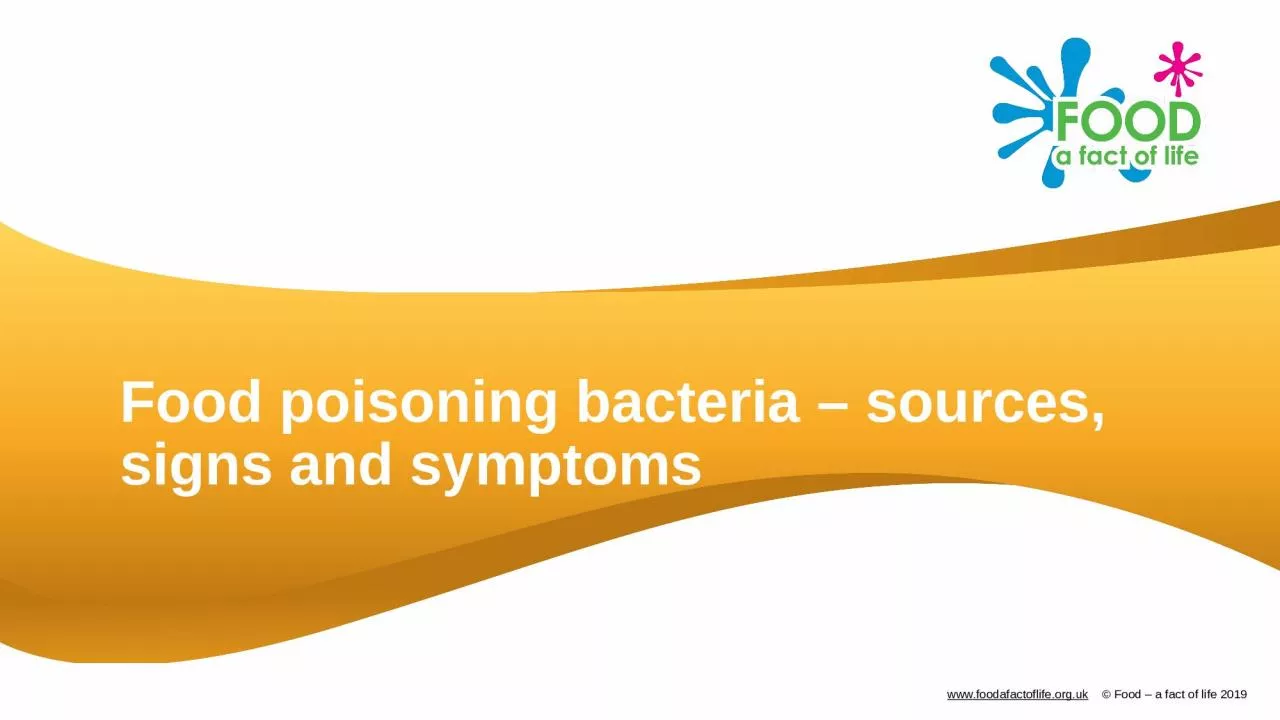

Causes of food poisoning Food poisoning can be caused by bacterial contamination eg staphylococcus aureus from a food handlers dirty hands physical contamination eg hair nails or plasters in food ID: 918189
Download Presentation The PPT/PDF document "Food poisoning bacteria – sources, sig..." is the property of its rightful owner. Permission is granted to download and print the materials on this web site for personal, non-commercial use only, and to display it on your personal computer provided you do not modify the materials and that you retain all copyright notices contained in the materials. By downloading content from our website, you accept the terms of this agreement.
Slide1
Food poisoning bacteria – sources, signs and symptoms
Slide2Causes of food poisoning
Food poisoning can be caused by
:bacterial contamination, e.g. staphylococcus aureus from a food handler’s dirty hands;physical contamination, e.g. hair, nails or plasters in food;chemical contamination, e.g. cleaning chemicals.However, bacterial contamination causes most cases of food poisoning.
Slide3Sources of food poisoning bacteria
Sources of food poisoning bacteria include:
pests such as rats, mice, flies and cockroaches;birds;raw meat, poultry and eggs;shellfish;waste food and dirt;human handlers.
Slide4Campylobacter
Campylobacter is the most common cause of food poisoning in the UK.
The Food Standards Agency has been testing chickens for campylobacter since February 2014 and publishing the results as part of a campaign to bring together the whole food chain to tackle the problem.
Slide5Food poisoning bacteria - Campylobacter
Sources
Raw and undercooked poultry, unpasteurized milk, contaminated water.Signs and symptoms
Onset 2 – 5 days (can be longer). Fever, headache and dizziness for a few hours, followed by abdominal pain.
This usually lasts 2 – 7 days and can recur over a number of weeks.
Slide6Chicken
The Food Standards Agency advises that chicken is safe if consumers follow good kitchen practice
:cover and chill raw chicken - cover raw chicken and store at the bottom of the fridge so juices cannot drip onto other foods and contaminate them with food poisoning bacteria such as campylobacter;don’t wash raw chicken – thorough cooking will kill any bacteria present, including campylobacter, while washing chicken can spread germs by splashing;
Slide7Chicken
The Food Standards Agency advises that chicken is safe if consumers follow good kitchen practice
:wash used utensils - thoroughly wash and clean all utensils, chopping boards and surfaces used to prepare raw chicken;wash hands thoroughly with soap and warm water, after handling raw chicken - this helps stop the spread of campylobacter by avoiding cross-contamination;
cook chicken thoroughly - make sure chicken is steaming hot all the way through before serving. Cut into the thickest part of the meat and check that it is steaming hot with no pink meat and that the juices run clear.
Slide8Other food poisoning bacteria
Other bacteria that commonly cause food poisoning include:
Clostridium botulinum;Clostridium perfringens;
E Coli 0157;
Salmonella;
Staphylococcus aureus;
Bacillus cereus.
Slide9Clostridium
botulinum
SourcesFish and meat. Dust, soil and vegetables. Inadequately processed canned meat, vegetables and fish (faulty canning).
Signs
and
symptoms.
Onset 12-36 hours. Voice change, double vision, drooping eyelids, severe constipation.
Death within a week or a slow recovery over months.
Slide10Clostridium
perfringens
SourcesAnimal and human waste. Dust, soil and vegetables. Raw meat. Insects.
Signs
and symptoms
Onset 12-18 hours. Abdominal pain, diarrhoea and nausea.
This
usually lasts 12 – 48 hours.
Clostridium
perfringens
forms spores
. Some forms produce a toxin in the intestine that causes illness.
Slide11E Coli 0157
Sources
Raw and undercooked meat and poultry. Unwashed vegetables. Contaminated water.Signs and symptoms
Onset usually 3-4 days. Diarrhoea, which may contain blood, can lead to kidney failure or death.
Slide12Salmonella
Sources
Raw meat, poultry and eggs. Flies, people, sewage and contaminated water.Signs and symptoms
Onset 6-48 hours. Headache, general aching of limbs, abdominal pain and diarrhoea, vomiting and fever.
This usually lasts 1 – 7 days, and rarely is fatal.
Slide13Staphylococcus aureus
Sources
Humans: nose, mouth and skin. Untreated milk.Signs and symptoms
Onset
1 – 6 hours. Severe vomiting, abdominal pain, weakness and lower than normal temperature.
This usually lasts 6 – 24 hours
.
Slide14Bacillus cereus
Sources
Rice and cereals. Dust, soil and vegetables.Signs and symptoms
Ranges
nausea and vomiting and abdominal cramps and has an incubation period of 1 to 6 hours
.
This
usually lasts less than 24 hours after onset.
Bacillus cereus forms spores and releases toxins which cause illness.
Slide15Food poisoning bacteria – sources, signs and symptoms
For further information, go to:
www.foodafactoflife.org.uk